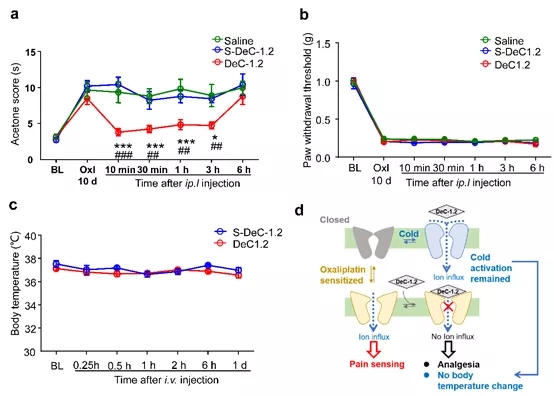Cancer is a major health hazard for mankind. Chemotherapy is the most prevalent way in the battle against cancer. However, its side effects may severely erode patients' living standards. For example, oxaliplatin tends to induce acute neurotoxicity marked by cold allodynia in the hands and feet of patients. Unfortunately, there has been no effective treatment against such neuropathy yet. The transient receptor potential melastatin 8 (TRPM8) ion channel is critically involved in the pathogenesis of oxaliplatin-induced cold allodynia. The discoverer of TRPM8 and other temperature-sensing TRP channels won the Nobel Prize in Physiology or Medicine in 2021. Therefore, it is worthwhile to develop regulatory molecules that can precisely target the TRPM8 ion channel to reduce platinum-based chemotherapy-induced neuropathic pain.
Prof. YANG Fan at the Zhejiang University School of Medicine, Prof. XU Zhenzhong at the Zhejiang University School of Brain Science and Brain Medicine, and Prof. YANG Shilong at Northeast Forestry University conducted collaborative research in this field. Their research findings are published in a research article entitled "Rational design of a modality-specific inhibitor of TRPM8 channel against oxaliplatin-induced cold allodynia" in the journal Advanced Science on October 17.
Platinum-based drugs are commonly used in chemotherapy, but they may produce side effects. For instance, oxaliplatin is extensively applied as a first-line chemotherapeutic drug for many tumors, such as colorectal and gastric cancers. However, it is inclined to induce acute neurotoxicity in up to 89% of patients taking this drug, featured by cold allodynia in the hands and feet of patients where a normally cool temperature is detected as extreme coldness to trigger pain sensation. So far, no effective treatment has been developed to cure this neuropathy.
The TRPM8 ion channel has a bearing on the pathogenesis of oxaliplatin-induced cold allodynia. TRPM8 is a non-selective cation channel highly expressed in nociceptive neurons. As this channel is activated at temperature lower than 28 °C, it is a sensor for coolness in mammalians. Moreover, TRPM8 is a polymodal receptor also activated by chemical ligands such as menthol and icilin, as well as membrane depolarization. In the mouse model of oxaliplatin-induced cold allodynia, the expression level of TRPM8 channel in the nociceptive dorsal root ganglion (DRG) neurons is significantly elevated. More importantly, in TRPM8 knock-out mice, the oxaliplatin-induced cold allodynia is also abolished. Therefore, TRPM8 channel is a validated target for oxaliplatin-induced cold allodynia.
Though there is no peptide toxin targeting TRPM8 channel identified from venomous animals, many small molecules have been screened and developed as TRPM8 inhibitors. Most of these inhibitors non-discriminatively suppress all modes of TRPM8 activation, so they often cause hypothermia and changes in acute cold sensation in patients and thus failures in clinical trials. To address such limitations in pan-mode inhibitors, one of the effective strategies is to develop modality-specific TRPM8 inhibitor that spares cold activation of this channel.

In vivo effect of DeC-1.2 against oxaliplatin-induced cold allodynia
To selectively target TRPM8 channels against cold allodynia, a cyclic peptide DeC-1.2 is de novo designed with the optimized hot-spot centric approach. DeC-1.2 can specifically inhibit the ligand activation of TRPM8 but not the cold activation as measured in single-channel patch clamp recordings. It is further demonstrated that DeC-1.2 abolishes cold allodynia in oxaliplatin treated mice without altering body temperature.






